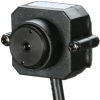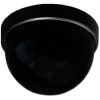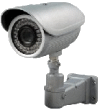
Pinhole Cameras: Pin hole cameras have a very tiny lens, although not quite the size of a pin head. Many times pinhole cameras provide wireless video and battery operation. A power supply can also be used instead of batteries. A wireless receiver is used to convert the signal into a Composite signal or some other format. It can then be viewed on a TV or computer or recorded. If you have interference problems, multiple receivers can be used with a single camera.




Hidden Cameras: Cameras are now small enough that they can be hidden in anything: Clocks, Teddy Bears, Books, Smoke Detectors, Exit Signs, Motion Detectors, Computer Speakers, Plants, VCRs... Many times these are just pinhole cameras placed in an ordinary object, and it is much cheaper to do it yourself. An observant babysitter might wonder why you decided to place a teddy bear on top of your entertainment center, and fake books don't work if they are the only books on a bookshelf.



Types of Cameras
As homeowners ourselves, we understand the distinct security needs of our residential customers. Part of owning a home or residential property is keeping it safe and protected from intruders. The threat of a break-in, trespassers, and vandalism to your home can prevent you from feeling comfort, peace of mind, and most importantly — secure and safe.
At TESS, our team will work with you to develop a custom surveillance system tailored to your home or residential unit. As a full-service video security integrator, we help you plan, configure, and operate your home surveillance system to ensure peak performance.
With a wide range of camera technologies and body styles, you may want to first think about what your preferences are in terms of appearance and design. Do you need a video surveillance camera that is engineered to see at night? Do you need several cameras? Do you want your security cameras to be made visible to the onlooker, or are aesthetics and concealment more important to you? These are questions every homeowner should consider.
Bullet Camera: These cameras are about the size of a roll of quarters or smaller. They typically don't have a very wide angle lens but are good for surveilling a small area. These cameras are small enough that they can sometimes be hidden easily.

Pan, Tilt, Zoom Camera: As their name implies, these types of cameras can pan (rotate back and forth, sometimes a full 360 degrees), tilt (move up & down) and zoom (focus in and out). The example on the left is a simple dome camera, but indoor cameras and some fixed box camera mounts also have this ability.

Outdoor Camera: Don't use a camera outside unless the camera says it is specifically designed for outdoor use. Some cameras are designed to withstand and function in rain, high humidity, and extreme high and low temperatures. Other cameras can handle the humidity and temperature extremes, but have to be placed in a metal enclosure for protection from the elements. Placing an indoor camera in a sealed enclosure can still cause problems due to humidity and temperature.

Fixed Box Camera: Fixed box cameras are typically High Quality cameras with lenses that can be focused. The camera can be mounted to a rotating arm to to cover a larger area. These cameras typically aren't found in a home.

Dome Cameras: There are several advantages to dome cameras. Ceiling mounted rotating dome cameras provide a 360 degree view of an area. For preventing theft in a store or preventing vandalism outside, a darker dome camera hides the lens so that the person doesn't know if the camera is aimed at them. Dome cameras also don't have exposed wires providing some degree of tamper proofing. There are many types of dome cameras: low light, Infrared, indoor/outdoor...

Vandal Proof Camera: Vandal cameras are not indestructible. They simply don't have any exposed wires to make tampering easy. The wires are either protected by the arm of the camera mount or the camera is flush with a wall / ceiling as in a dome camera.

Infrared (IR) Camera: The LEDs around the lens of this camera emit Infrared light. This light is then captured by the camera itself allowing it to see heat. IR cameras are typically Black & White cameras that function as low-light cameras when IR is not needed. IR cameras have a 0 lux rating since they can see in no light, but the IR emitters have a range that limits the distance that the camera will work. Also, IR cameras are specifically designed for indoor or outdoor operation. Too many IR emitters in a small room can overpower the sensor leading to a washed out image.

Wireless Camera: These cameras are convenient for watching a specific room or area. Although the video signal is wireless (letting them transmit to any TV in the home) they still require power. They can run from batteries or plug into a wall outlet. Some wireless cameras use the same frequencies as WiFi Internet and will jam your wireless internet connection. Also, you may not be able to operate more than 1 or 2 at a time.

Low Light Camera: As the name indicates, these are cameras that operate in low light. They are typically Black & White cameras with a large lens that allows them to capture a lot of light. More expensive cameras will operate in Color during the day and switch to Black & White at night. Check the lux rating on the camera to see how much light is required for the camera to capture an image.

